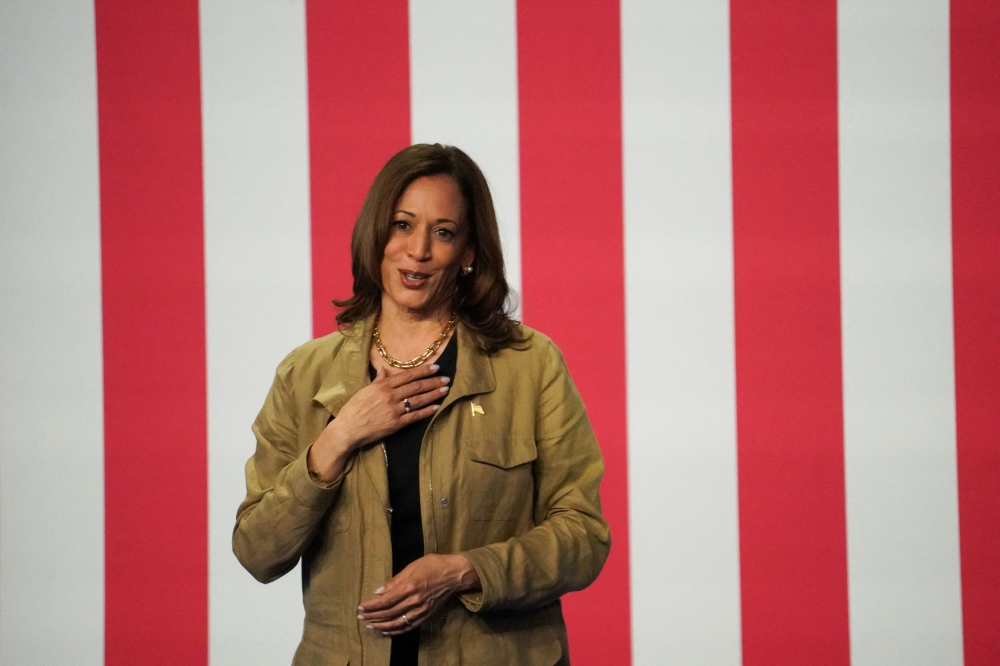- Harris pushes China to crack down on fentanyl precursor chemicals
- Harris blasts Trump for anti-immigrant message
- Eyes more severe criminal charges against illegal border crossers
DOUGLAS (United States), Sept 28 — Democratic Vice President Kamala Harris visited the US-Mexico border for the first time in her 2024 presidential campaign yesterday, calling for tighter asylum restrictions and vowing to make stopping fentanyl from entering the US a “top priority.”
Harris outlined her plans to fix “our broken immigration system” in Douglas, Arizona, a border town of fewer than 17,000 people, while accusing her Republican rival Donald Trump of “fanning the flames of fear and division” over the impact of immigrants on American life.
Some 7 million migrants have been arrested crossing the US-Mexico border illegally during President Joe Biden’s administration, according to government data, a record high number that has fuelled criticism of Biden and Harris from Trump and his fellow Republicans.
Immigration is a top issue for voters. Arizona is a closely contested election state, with a high population of Latino voters sought by both parties. The nation’s porous southern border remains a source of fentanyl, a leading cause of drug overdoses in the United States.
Harris called for more punitive measures for people crossing the border illegally, following an asylum ban for those entering illegally, a move Biden took this year that has sharply reduced illegal crossings.
“I will take further action to keep the border closed between ports of entry. Those who cross our borders unlawfully will be apprehended and removed and barred from re-entering for five years,” Harris said.
“We will pursue more severe criminal charges against repeat violators, and if someone does not make an asylum request at a legal point of entry and instead crosses our border unlawfully, they will be barred from receiving asylum,” she said.
Harris emphasised her goal of a “humane” immigration programme, saying she would with Congress to create a pathway to citizenship for “Dreamers” — hundreds of thousands of people brought into the US illegally as children. They were a priority for Democrats for a decade but were left out of a failed immigration bill that Biden had backed.
“I reject the false choice that suggests we must either choose between securing our border or creating a system of immigration that is safe, orderly and humane,” Harris said. “We can and we must do both.”
In Douglas, Harris spoke to Customs and Border Protection officials and viewed part of a border barrier built between 2011 and 2012 during the administration of Democrat Barack Obama, the White House said.
She also received a briefing on the CBP’s drug enforcement operations and viewed inspection technology used to seize illegal drugs, including fentanyl, the campaign said, noting that border officials stopped more fentanyl at ports of entry in 2022 and 2023 than in the previous five fiscal years combined.
Harris was introduced by Theresa Guerrero, whose 31-year-old son Jacob Guerrero died from fentanyl poisoning. She accused Trump of blocking the bipartisan border security bill aimed at stemming the flow of fentanyl. The bill was blocked by the Senate in February, after Trump pressed Republicans to reject any compromise.
Biden and Harris accuse Trump of killing the measure to keep immigration alive as a campaign issue.
Harris said she would revive the legislation, which would add 1,500 Border Patrol agents and other personnel, 4,300 asylum officers, 100 immigration judges and new drug detection technology.
The vice president said she would target the “entire global fentanyl supply chain.” She said China was starting to crack down on fentanyl precursor chemicals but needed to do more.
Fentanyl overdoses have surged to become the leading cause of death for Americans between the ages of 18 and 45. Over 107,000 Americans died from drug overdoses in 2023.
Harris pledged to double funding for the prosecution of trans-national criminal organisations and cartels, and modernise US screening and vetting infrastructure.

Immigration top issue
Trump and his running mate JD Vance have increased their criticism of immigrants in recent weeks, repeating falsehoods about legal Haitian immigrants in Vance’s home state of Ohio and suggesting that immigrants are committing crimes and stealing jobs from US citizens.
Yesterday, Trump blamed Harris for the rising trend of irregular migration.
“The architect of this destruction is Kamala Harris,” Trump said at Trump Tower in Manhattan. “She keeps talking about how she supposedly wants to fix the border. We would merely ask, Why didn’t she do it four years ago? It’s a very simple question.”
He also accused Harris of turning small towns in the US into “blighted refugee camps.”
A Reuters/Ipsos poll last month found that 43 per cent of voters favoured Trump on the issue of immigration and 33 per cent favoured Harris, while 24 per cent either did not know, chose someone else or did not answer.
Harris, a former prosecutor, was California’s attorney general before being elected to the US Senate and then vice president. Her California remit included targeting gangs that operate on both sides of the border and traffic in drugs, guns and people.
Biden tasked Harris with dealing with the root causes of migration from Central America, a diplomatic issue on which her record is mixed.
Emigration from Latin America, the Caribbean and Asia to the United States has created unease among voters concerned about what the trend means for the US economy, crime rates and culture. The share of American residents born abroad rose by nearly a fifth to 47.8 million from 2010 to 2023, according to the US Census Bureau. — Reuters






















